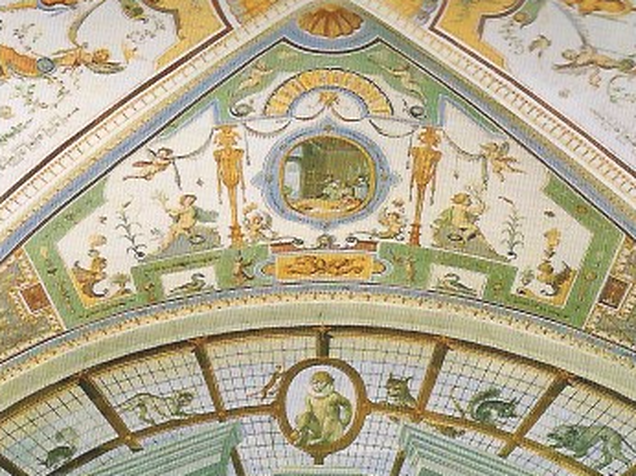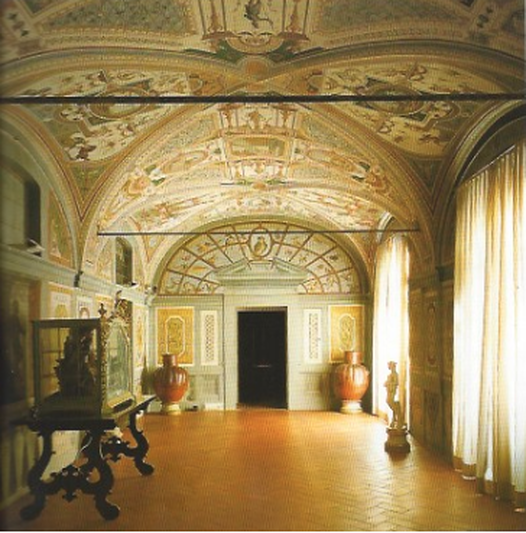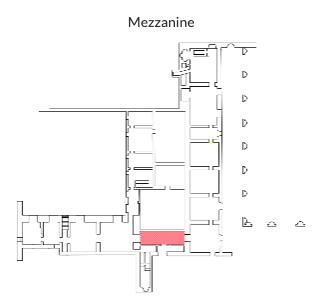The Small Loggia
Loggetta

The reign of Ferdinando I was marked by a period of great artistic fervor. A new phase of decorative efforts began with the frescoes in Palazzo Pitti after the death of Cosimo II de’Medici in 1621. At that moment, the young Ferdinando II was still a minor and the government of the grand duchy was entrusted to the regency of his mother, Maria Maddalena of Austria, and his older grandmother, Cristina of Lorraine. During that period, from 1621 to 1628, a rich pictorial cycle was provided at Poggio Imperiale and at Cardinal Carlo’s Casino Mediceo. At the Pitti the regents commissioned the decoration of many rooms on the ground floor. They also decorated rooms on the mezzanine, including the tesoretto and the four adjoining rooms (Loggetta, the Exotic Room, the Chinese Porcelain Room, and the Japanese Porcelain Room). They were originally, at least in part, were open to the loggia. This program of embellishing the residence was entrusted to Giulio Parigi, to whom Cosimo II had previously entrusted the architectural program of enlarging the palace. The decorative program included frescoes for the loggia that is traditionally called the Galleria del Poccetti, the small chapel behind, and the ceiling of the Stove Room that, without doubt, constitute the most representative work of the regency period.
While the Loggetta was not finally enclosed until the 19th century, the frescoes on the vaulted ceiling date from the regency of Maria Maddelena of Austria. The walls, in all likelihood, remained unfinished if, as Mario Scalini has suggested, the room was used as an armory (to which the figures on the ceiling might allude). The wall frescoes probably date from a succeeding period. Stylistically they suggest the work of Jacopo Chiavistelli who was working in the second half of the 17th century in other parts of the palace.
The frescoes on the vault (see above) seem to be referred to in a payment of about 1628 made to Paolo Antonio Guerrini (? - Firenze 1656), a student and collaborator of Michelangelo Cinganelli, for "diverse pitture di fregi, grottesche dorate...fatte nello stanze nuove di S.A.S. (friezes, gold grottesques...made in the new room of His Royal Highness)". The specialist who executed the two lunettes on the short ends, with figures of birds and other animals depicted in the naturalistic way preferred by Michelangelo Cinganelli's workshop, could be Giovan Battista Cartei, a petit maître known particularly for his ceilings with a pergola full of birds, as noted in a document of 1638 at Casa Buonarroti.
Elisa Acanfora, "La decorazione delle loggette", Palazzo Pitti: l'arte e la storia, Nardini, 2000, pp. 57-59.
While the Loggetta was not finally enclosed until the 19th century, the frescoes on the vaulted ceiling date from the regency of Maria Maddelena of Austria. The walls, in all likelihood, remained unfinished if, as Mario Scalini has suggested, the room was used as an armory (to which the figures on the ceiling might allude). The wall frescoes probably date from a succeeding period. Stylistically they suggest the work of Jacopo Chiavistelli who was working in the second half of the 17th century in other parts of the palace.
The frescoes on the vault (see above) seem to be referred to in a payment of about 1628 made to Paolo Antonio Guerrini (? - Firenze 1656), a student and collaborator of Michelangelo Cinganelli, for "diverse pitture di fregi, grottesche dorate...fatte nello stanze nuove di S.A.S. (friezes, gold grottesques...made in the new room of His Royal Highness)". The specialist who executed the two lunettes on the short ends, with figures of birds and other animals depicted in the naturalistic way preferred by Michelangelo Cinganelli's workshop, could be Giovan Battista Cartei, a petit maître known particularly for his ceilings with a pergola full of birds, as noted in a document of 1638 at Casa Buonarroti.
Elisa Acanfora, "La decorazione delle loggette", Palazzo Pitti: l'arte e la storia, Nardini, 2000, pp. 57-59.

